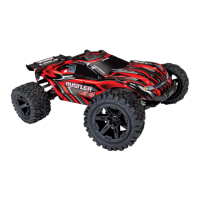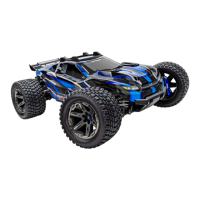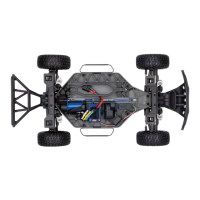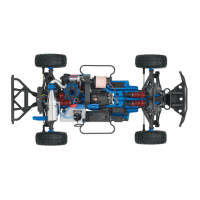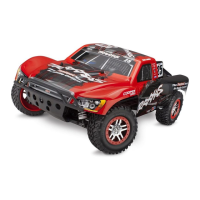Do you have a question about the Traxxas RUSTER 4x4 BRUSHLESS and is the answer not in the manual?
Information on how to contact Traxxas for support and available options.
Overview of procedures to get the model running quickly.
Instructions to register the product online for better customer service.
Explanation of icons used for warnings, hints, and cross-references in the manual.
Contact information and resources for Traxxas technical support and service.
Key safety advice regarding model operation, interference, and heat.
Precautions for operating the electronic speed control and its components.
Encouragement and information on recycling NiMH batteries.
Critical warnings about LiPo battery fire hazards and proper handling.
Detailed warnings and precautions for LiPo battery usage, charging, and storage.
General precautions for charging and handling all types of batteries.
Further safety guidelines for charging and discharging batteries.
List of tools included with the model.
List of essential equipment needed to operate the model.
Optional but useful tools and supplies for an R/C toolbox.
Step-by-step guide for removing and installing the model's body.
Labeled diagram identifying key parts of the Rustler 4X4 Brushless.
A step-by-step guide to get the model running quickly.
Instructions on how to apply optional decals to the model.
Introduction to the TQ 2.4GHz transmitter and its features.
Definitions of key terms related to the radio and power systems.
Detailed definitions of various technical terms related to the radio system.
Explanation of the radio system's two-channel operation and technology.
Crucial precautions for maintaining radio range and antenna integrity.
Diagram illustrating the wiring connections for the BL-2s electronic speed control.
Diagram showing the model's electronic component connections.
Identification of controls and components on the transmitter and receiver.
Diagram showing connections for the BL-2S ESC.
Step-by-step instructions for installing batteries in the transmitter.
Guide to choosing compatible batteries for the model.
Recommendations for choosing the correct battery charger.
Explanation of the Traxxas Battery iD feature for automatic charger recognition.
Instructions for installing the battery pack into the model.
Description of the Traxxas High-Current Connector's benefits and design.
Identification and function of the radio system controls.
Essential rules for safe and proper operation of the radio system.
Procedures for adjusting steering trim and reversing channels.
Explanation of how to use the reverse function of the throttle trigger.
Steps for checking and adjusting the radio system's operation.
Procedure for testing the radio system's range before operation.
Advice on maintaining control at higher speeds and longer distances.
Instructions for binding the transmitter and receiver if necessary.
Explanation of the Failsafe function and its activation.
Table explaining transmitter LED status indicators.
Table explaining receiver LED status indicators.
Explanation and settings for Low-Voltage Detection on the BL-2s ESC.
Steps to check the current Low-Voltage Detection setting.
Procedure to enable LiPo battery protection or disable for NiMH.
How to reset transmitter settings to factory defaults for ESC programming.
Step-by-step guide to calibrate the ESC and transmitter.
How to operate the speed control and test its programming.
How to select different driving profiles (Sport, Race, Training).
Details on the characteristics of each ESC profile.
Steps to select Sport Mode for the ESC.
Steps to select Race Mode for the ESC.
Steps to select Training Mode for the ESC.
Explanations of ESC LED indicators and protection modes.
Benefits of Training Mode for new drivers.
Quick tips for switching between ESC profiles.
Key safety and operational precautions to keep in mind while driving.
Factors affecting battery run time and how to estimate it.
Advice on maximizing battery run time.
How battery mAh rating affects performance and speed.
Guidelines and precautions for operating the model in wet environments.
Precautions for operating the motor in wet conditions and avoiding damage.
Procedures for cleaning and maintaining the model after wet use.
Specific maintenance tasks for bearings, gears, and motor after wet use.
Instructions for maintaining the receiver box's watertight seal.
Steps for removing and installing the receiver and associated wiring.
Detailed steps for installing the receiver and managing wires.
Instructions for correctly positioning the receiver antenna for optimal range.
How to set the correct gear mesh using the fixed gear adapter or manually.
How to adjust shock mounting positions for different driving conditions.
Advice on tuning shocks with pistons, oil viscosity, and preload spacers.
Chart showing recommended motor screw positions for gear mesh.
Chart of recommended gear combinations for different driving styles.
Steps to re-center the steering servo and adjust trim.
Explanation of how motor RPM and gearing affect performance.
How to adjust the slipper clutch for optimal power transfer and tire spin prevention.
Information on selecting and using aftermarket wheels and tires.
How to tune front and rear gear differentials using silicone oil.
Steps for removing the front differential for service.
Recommended initial adjustment for the slipper clutch.
Steps for removing the rear differential for service.
Instructions for refilling differentials with fluid.
A checklist for inspecting the model for damage and wear.
Regular maintenance tasks for slipper clutch, chassis, and steering.
Maintenance procedures for the motor, including cleaning and lubrication.
Maintenance for shocks, including oil levels and rebuilds.
Periodic inspection of suspension components for damage.
Inspection of the driveline for wear and proper function.
Procedures for storing the model properly when not in use.
Instructions for removing front and rear suspension modules.
Step-by-step guide to removing the front suspension.
Step-by-step guide to removing the rear suspension and slipper clutch.
| Scale | 1/10 |
|---|---|
| Drive Type | 4WD |
| Transmission | Single-Speed |
| Battery | 2S LiPo |
| Speed Control Type | VXL-3s Electronic Speed Control |
| Radio System | TQi 2.4GHz Radio System |
| Water Resistance | Yes |



